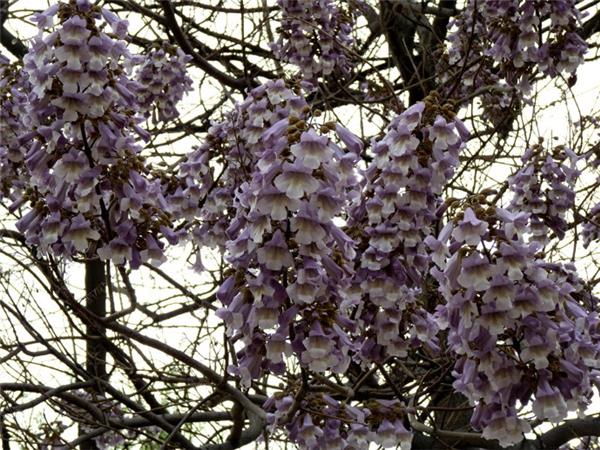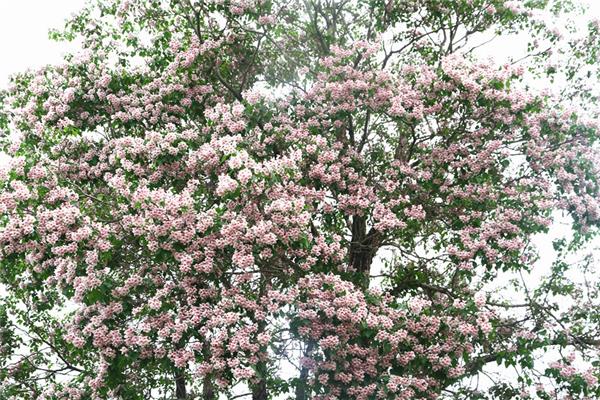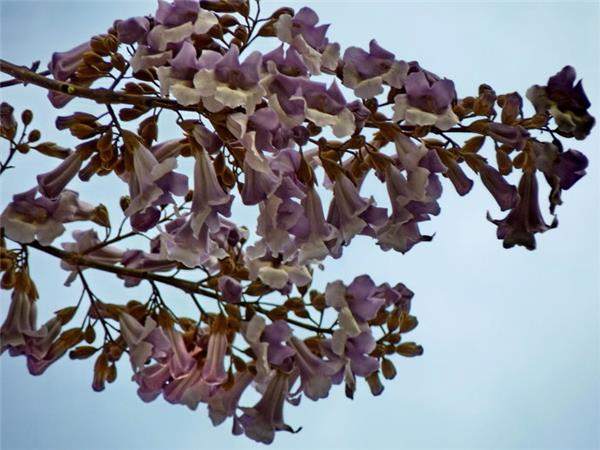Planting methods and pest control of paulownia tomentosa
To raise a good tree, we should pay more attention to planting and maintenance after understanding its morphological characteristics and habits, otherwise it will easily lead to diseases and insect pests.

1. Morphological characteristics of paulownia tomentosa
Deciduous trees, up to 20 m tall, grayish brown dry skin, smooth when young, shallowly longitudinally lobed when old, lateral branches growing obliquely, crown broadly ovate, branchlets green-brown puberulent, turning reddish brown smooth, internodes short, pith small solid, lenticels with yellowish-brown protuberances, simple leaves alternate, large leaves triangular and narrow-ovate, 12-28 cm long, leaves 2-3 times as long as leaf width, leaves entire, leaf surface dark green bright, abaxially dense stellate hairs There are long petioles, flowers bisexual, terminal narrow panicle, flowers tubular funnel-shaped, lavender, 5-lobed, outer short hairs, inner white smooth, dense purple lines and purple spots. Capsule rhomboid-ovate, slender, tip beaked, pericarp woody, covered with fine hairs, 2-valved when ripe, seeds small, flattened, membranous winged
Second, the growth habits of paulownia.
Xiguang is not tolerant to shade, has strong cold tolerance, is more resistant to drought, is not strict with soil properties, but is very sensitive to fertility and is afraid of stagnant water and waterlogging. Strong sunshine, like warmth, teach cold tolerance, fast growth.

Third, the seedling raising technique of paulownia with plastic film mulching.
1. Fine soil preparation: paulownia likes light, chooses sandy loam with loose soil, high fertility, irrigation conditions, flat terrain, PH value of 6.5-7.5m and groundwater level below 1.5m. Do not choose continuous cropping land to raise seedlings, should choose places where there are no serious underground pests, do not rake after turning 40cm in autumn and winter, rake and protect the ground in spring, so that the ground is flat and full.
two。 Fertilization and ridging: combined with the application of sufficient bottom fertilizer in autumn, no base fertilizer before winter and timely application in early spring, 500 kg of farm manure per mu, 35 kg of calcium superphosphate and 1.5 kg of 50% phoxim granules per mu were applied to disinfect the soil. The ridging time is at the end of February. The method is to draw lines with row width 50cm, plough ditches along odd lines, break even lines after applying base fertilizer, and cultivate large ridges to the left and right sides with topsoil. The ridge height is 15 cm, the ridge width 60 is fish back shape, the whole ridge surface is the same, the top is empty and the bottom is solid, the ridge width is 35cm, the ridge end is straight, which is beneficial to film mulching.
3. Planting: in roadside, canal side, river side, can be planted in rows, the plant distance can be 3 to 5 meters; in areas with better conditions, Amorpha can also be planted among plants. It can be planted in strips or blocks next to houses and villages, and the initial planting density is 4 × 4 meters. Afforestation is generally carried out after defoliation in autumn to before germination in the spring of the second year. In some areas, planting with leaves in autumn can also achieve better results.
4. Seedling release and weeding: after burying roots and plastic film, the birth of seedlings should be observed in time, and one seedling should be released for each inspection. Release as soon as you go out, and when the seedling is halfway out, you can cut the unfinished part at one time by burying the root. In this way, it saves labor and avoids burning seedlings, and after the seedlings come out of the film, seal the seedling holes with soil to prevent ventilation from running away from moisture, cause grass famine, reduce the effect of film mulching, and prevent the breeding of weeds in the film.

IV. Control measures of diseases and insect pests of paulownia
1. Cultivate disease-free seedlings. Disease-free mother trees are strictly selected for seed and root collection. Pay attention to picking roots from the roots of seedlings. Soaking the roots in 40 ℃ ~ 50 ℃ warm water for 30 minutes or 50 ℃ warm water plus oxytetracycline (1000 × 10 ~ (- 6)) for 20 minutes after root harvesting had better disease control effect. There is no need to leave root seedlings or flat stubble seedlings for afforestation, it is best to carry out seed breeding in places where the disease is serious.
two。 The diseased branches were trimmed or annularly peeled. Because the pathogen runs with the host assimilation products in the host, the phloem can be annularly stripped off at the base of the diseased branch before the foliage of paulownia in spring. The girdling width depends on the thickness of the girdled branch, which is generally 5-10 cm, which can not be healed to prevent the pathogen from flowing back from the root to the upper part of the tree.
3. medication. Intramedullary injection. 1. If the pith of the 2-year-old seedling or young tree is soft, the medicine can be injected directly into the pulp with a needle; the big tree can drill two holes up and down the side of the diseased branch at the base of the trunk, deep into the pith, and then slowly inject the liquid into it. Root aspiration therapy. Dig up the soil 50 meters away from the base of the tree trunk, find a 1 meter thick root in the exposed root, put the liquid into a bottle and insert the root. The mouth of the bottle is tightly covered with plastic cloth. After a certain period of time, the liquid is inhaled by the tree.
From 4.5 to June, timely chemical control of disease-borne insects was carried out.

As long as we strictly carry out protection and control in accordance with the above measures, I believe that the probability of diseases and insect pests far away from the catalpa leaf paulownia planted by you will be greatly improved. of course, in addition to the above points, but also in accordance with the habits of catalpa leaf paulownia, take more care of it in light, moisture and other aspects.
It is believed that the probability of diseases and insect pests far away from the catalpa leaf paulownia planted by you will be greatly improved. of course, in addition to the above points, we should also take more care of it in light, water and other aspects according to the habits of catalpa leaf paulownia.
Related
- Wuhan Hospital Iron Tree Blooming Result Was Instantly Frightened by the Gardener Master
- Which variety of camellia is the most fragrant and best? Which one do you like best?
- What is the small blue coat, the breeding methods and matters needing attention of the succulent plant
- Dormancy time and maintenance management of succulent plants during dormancy
- Minas succulent how to raise, Minas succulent plant pictures
- What are the varieties of winter succulent plants
- How to raise succulent plants in twelve rolls? let's take a look at some experience of breeding twelve rolls.
- Attention should be paid to water control for succulent plants during dormant period (winter and summer)
- Watering experience of twelve rolls of succulent plants
- Techniques for fertilizing succulent plants. An article will let you know how to fertilize succulent plants.



